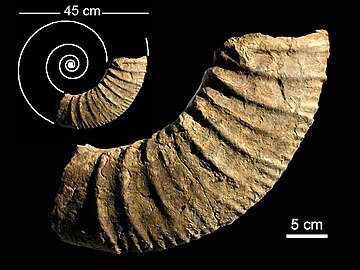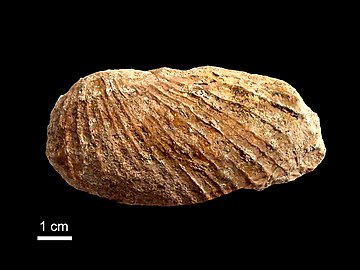Agrio Formation
| Agrio Formation | ||
|---|---|---|
Ma | ||
Approximate paleocoordinates 38°12′S 33°42′W / 38.2°S 33.7°W | | |
| Region | Mendoza & Neuquén Provinces | |
| Country | Argentina | |
| Extent | Neuquén Basin | |
| Type section | ||
| Named for | Agrio River | |
| Named by | Weaver | |
| Year defined | 1931 | |
The Agrio Formation is an
The Agrio Formation is considered the third most important source rock in the hydrocarbon-rich Neuquén Basin, after the Vaca Muerta Formation and Los Molles Formation. Similarly to these older units, it is potentially a source of shale gas.
This formation has provided fossils of
Description

The Agrio Formation was first described by Weaver in 1931 and its three members, from bottom to top: Pilmatué, Avilé and Agua de la Mula Members, were defined by Leanza and Hugo in 2001.[5][1][3] The formation crops out in an approximately 50 kilometres (31 mi) wide band from north to south along 70° longitude west, from 37° to 39° south in the northern-central part of the Neuquén Basin.[6] The southern termination of the formation is the Huincul High, formed by the Huincul Fault. Towards the east in the basin, the formation grades into the Centenario Formation.[3]
Stratigraphy

The Agrio Formation is included in the
Lithologies

The Agrio Formation is primarily composed of
Depositional environment
The Agrio Formation was deposited in a post-rift setting of the Neuquén Basin, probably representing a tectonic regime of
Fossil content
The formation has provided many fossils of
In
The decapod Palaeohomarus pacificus,[23] and ammonites Curacoites rotundus and Sabaudiella riverorum were described from the formation in 2012,[24] the gastropods Ampullina pichinka and Mesalia? kushea in 2016,[25] and the ammonite Comahueites aequalicostatus in 2018.[26]
Newly described species of fish,
The first known brittle stars in the Southern Hemisphere and Cretaceous age have been identified in Agrio Formation.[28] However, fossils are not complete enough to define species.[28]
Petroleum geology
The Agrio Formation is considered the third-most important
Gallery
-
Ammonite from the Agrio Formation
-
Bivalve from the formation
-
Bivalve (Ptychomya koeneni)
See also
- List of dinosaur-bearing rock formations
- Caiuá Formation, contemporaneous fossiliferous formation of the Paraná Basin
- Cerro Barcino Formation, contemporaneous fossiliferous formation of the Cañadón Asfalto Basin
- Zapata and Río Belgrano Formations, contemporaneous fossiliferous formations of the Magallanes or Austral Basin
References
- ^ a b Weaver, C. E. (1931). Paleontology of the Jurassic and cretaceous of west central Argentina. In Memoires of the University of Washington (Vol. 1, pp. 1–599).
- ^ a b Voglino, 2017, p.39
- ^ a b c Voglino, 2017, p.49
- ^ Gómez Dacal et al., 2018, p.113
- ^ a b Archuby, F. M. (2009). Taphonomy and palaeoecology of benthic macroinvertebrates from the Agua de la Mula Member of the Agrio Formation, Neuquén Basin (Neuquén province, Argentina): sequence stratigraphic significance [Würzburg University]. http://www.opus-bayern.de/uni-wuerzburg/volltexte/2009/3717/index.html
- ^ a b Voglino, 2017, p.50
- ^ Leanza, H. A., Hugo, C. A., & Repol, D. (2001). Hoja Geológica 3969-I, Zapala. Provincia del Neuquén. In Referencia bibliográfica LEANZA, H.A., C. A. HUGO y D. REPOL, 2001. Hoja Geológica 3969-I, Zapala. Provincia del Neuquén. Instituto de Geología y Recursos Minerales, Servicio Geoló- gico Minero Argentino. Boletín (Vol. 275).
- ^ Olivo et al., 2016, p.218
- ^ Gallina et al., 2014, p.2
- ^ a b c Voglino, 2017, p.51
- ^ Archuby, F. M., & Fürsich, F. T. (2010). Facies analysis of a higly [sic?] cyclic sedimentary unit: the Late Hauterivian to Early Barremian Agua de la Mula Member of the Agrio Formation, Neuquén Basin, Argentina. Beringeria, 41, 53–106. https://doi.org/https://doi.org/10.15517/rbt.v56i3.27147
- ^ Archuby, F. M., Wilmsen, M., & Leanza, H. A. (2011). Integrated stratigraphy of the Upper Hauterivian to Lower Barremian Agua de la Mula Member of the Agrio Formation, Neuquén Basin, Argentina. Acta Geologica Polonica, 61(1), 1–26.
- ^ Archuby, F. M., & Fürsich, F. T. (2010). Facies analysis of a higly cyclic sedimentary unit: the Late Hauterivian to Early Barremian Agua de la Mula Member of the Agrio Formation, Neuquén Basin, Argentina. Beringeria, 41, 53–106. https://doi.org/https://doi.org/10.15517/rbt.v56i3.27147
- ^ Cataldo, 2012
- ^ Aguirre Urreta, 1998
- ^ a b Kauffman & Leanza, 2004
- ^ Agrio Formation at Fossilworks.org
- ^ Ballent, S., Concheyro, A., Náñez, C., Pujana, I., Lescano, M., Carignano, A. P., Caramés, A., Angelozzi, G., & Ronchi, D. (2011). Microfósiles Mesozoicos Y Cenozoicos. Relatorio Del XVIII Congreso Geológico Argentino, September 2017, 489–528.
- ISSN 0716-0208.
- S2CID 233951814.
- ^ Lazo et al., 2018
- ^ a b Gouiric Cavalli et al., 2019
- ^ Aguirre Urreta et al., 2012
- ^ Aguirre Urreta & Rawson, 2012
- ^ Cataldo & Lazo, 2016
- ^ Aguirre Urreta & Rawson, 2018
- ^ Lazo, 2003
- ^ a b Fernández et al., 2019
- ^ Geologic Map, 2007, p.142
Bibliography
- General
- Balgord, Elizabeth A. 2017. Triassic to Neogene evolution of the south-central Andean arc determined by detrital zircon U-Pb and Hf analysis of Neuquén Basin strata, central Argentina (34°S–40°S). Lithosphere9. 453–462. .
- Balgord, Elizabeth A., and Barbara Carapa. 2014. Basin evolution of Upper Cretaceous–Lower Cenozoic strata in the Malargüe fold-and-thrust belt: northern Neuquen Basin, Argentina. Basin Research _. 1–24. Accessed 2019-02-22.
- Fernández, Diana E.; Luciana Giachetti; Stöhr Sabine; Ben Thuy; Damián E. Pérez; Marcos Comerio, and Pablo J. Pazos. 2019. Brittle stars from the Lower Cretaceous of Patagonia: first ophiuroid articulated remains for the Mesozoic of South America. Andean Geology 46(2). 421–432. Accessed 2019-06-15.
- Gómez Dacal, Alejandro R.; Lucía E. Gómez Peral; Luis A. Spalletti; Alcides N. Sial; Aron Siccardi, and Daniel G. Poiré. 2018. First record of the Valanginian positive carbon isotope anomaly in the Mendoza shelf, Neuquén Basin, Argentina: palaeoclimatic implications. Andean Geology 45. 111–129. Accessed 2019-02-22.
- Howell, John A.; Ernesto Schwartz; Luis A. Spalletti, and Gonzalo D. Veiga. 2005. The Neuquén Basin: An overview. Geological Society, London, Special Publications 252. 1–14. Accessed 2019-02-14.
- Leanza, Héctor A.; Federico Sattler; Ricardo S. Martínez, and Osvaldo Carbone. 2011. La formación Vaca Muerta y equivalentes (Jurásico tardío-Cretácico temprano) en la Cuenca Neuquina, 113–129. XVIII Congreso Geológico Argentino. Accessed 2019-02-14.
- Leanza, Héctor A. 2005. Las principales discordancias del Jurásico Superior y el Cretácico de la Cuenca Neuquina. Anales de la Academia Nacional de Ciencias Exactas, Físicas y Naturales 57. 147–155. Accessed 2019-02-14.
- Leanza, H.A.; S. Apesteguia; F.E. Novas, and M.S. De la Fuente. 2004. Cretaceous terrestrial beds from the Neuquén Basin (Argentina) and their tetrapod assemblages. Cretaceous Research 25. 61–87. Accessed 2019-02-16.
- Lebinson, Fernando; Martín Turienzo; Natalia Sánchez; Vanesa Araujo; María Celeste D'Annunzio, and Luis Dimieri. 2018. The structure of the northern Agrio fold and thrust belt (37°30’ S), Neuquén Basin, Argentina. Andean Geology 45. 249–273. Accessed 2019-02-22.
- Moyano Bohórquez, Fernando. 2004. Los sistemas sedimentarios de la Formación Bajada Colorada (Cretácico Temprano) en el sur de la Cuenca Neuquina, Argentina, 1–250. Universidad Nacional de La Plata. Accessed 2019-02-14.
- Olivo, Mariano S.; Ernesto Schwartz, and Gonzalo D. Veiga. 2016. Modelo de acumulación y evolución secuencial del intervalo cuspidal de la Formación Quintuco en su área tipo: implicancias para las reconstrucciones paleogeográficas del margen austral de la Cuenca Neuquina durante el Valanginiano. Andean Geology 43. 215–239. Accessed 2019-02-22.
- Voglino, Sergio. 2017. Caracterización del Miembro Pilmatué de la Formación Agrio como reservorio no convencional de tipo shale (MSc. thesis), 1–196. Universidad Nacional de Río Negro. Accessed 2019-02-23.
- Paleontology
- Aguirre Urreta, Beatriz, and Peter F. Rawson. 2018. New Valanginian-Hauterivian neocomitid ammonites from the Neuquén Basin, Argentina. Cretaceous Research 88. 149–157. Accessed 2019-02-26.
- Aguirre Urreta, Beatriz; Darío G. Lazo, and Peter F. Rawson. 2012. Decapod Crustacea from the Agrio Formation (Lower Cretaceous) of the Neuquén Basin, Argentina. Palaeontology 55(5). 1091–1103. Accessed 2019-02-26.
- Aguirre Urreta, Beatriz, and Peter F. Rawson. 2012. Lower Cretaceous ammonites from the Neuquén Basin, Argentina: A new heteromorph fauna from the uppermost Agrio Formation. Cretaceous Research 35. 208–216. Accessed 2019-02-26.
- Aguirre Urreta, M.B. 1998. The ammonites Karakaschiceras and Neohoploceras (Valanginian Neocomitidae) from the Neuquén Basin, West-Central Argentina. Journal of Paleontology 72. 39–59. Accessed 2019-02-25.
- Cataldo, Cecilia S., and Darío G. Lazo. 2016. Taxonomy and paleoecology of a new gastropod fauna from dysoxic outer ramp facies of the Lower Cretaceous Agrio Formation, Neuquén Basin, west-central Argentina. Cretaceous Research 57. 165–189. Accessed 2019-02-26.
- Cataldo, C.S.. 2012. A new Early Cretaceous nerineoid gastropod from Argentina and its palaeobiogeographic and palaeoecological implications. Cretaceous Research 40. 51–60. Accessed 2019-02-25.
- Gouiric Cavalli, Soledad; Mariano Remírez, and Jürgen Kriwet. 2019. New pycnodontiform fishes (Actinopterygii, Neopterygii) from the Early Cretaceous of the Argentinian Patagonia. Cretaceous Research 94. 45–58. Accessed 2019-02-26.
- Kauffman, E.G., and H.A. Leanza. 2004. A Remarkable New Genus of Mytilidae (Bivalvia) from the Lower Cretaceous of Southwestern Gondwanaland. Journal of Paleontology 78. 1187–1191. Accessed 2019-02-25.
- Lazo, Darío G.; Marianella Talevi; Cecilia S. Cataldo; Beatriz Aguirre Urreta, and Marta S. Fernández. 2018. Description of ichthyosaur remains from the Lower Cretaceous Agrio Formation (Neuquén Basin, west-central Argentina) and their paleobiological implications. Cretaceous Research 89. 8–21. Accessed 2019-02-26.
- Lazo, Darío G. 2003. The genus Steinmanella (Bivalvia, Trigonioida) in the lower member of the Agrio Formation (Lower Cretaceous), Neuquén Basin, Argentina. Journal of Paleontology 77. 1069–1085. Accessed 2019-02-25.
- Geologic map
- Rodríguez, María F.; Héctor A. Leanza, and Matías Salvarredy Aranguren. 2007. Hoja Geológica 3969-II, NEUQUÉN, provincias del Neuquén, Río Negro y La Pampa 1:250,000, 1–165. Instituto de Geología y Recursos Minerales. Accessed 2019-02-23.




